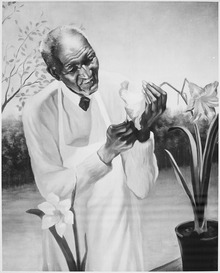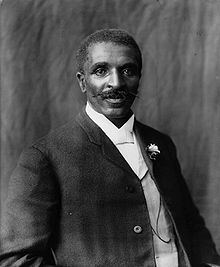
George Washington Carver
On his grave was written, He could have added fortune to fame, but caring for neither, he found happiness and honor in being helpful to the world.
Carver was born into slavery in Diamond Grove, Newton County, near Crystal Place, now known as Diamond Missouri, possibly in 1864 or 1865, though the exact date is not known. His master, Moses Carver, was a German American immigrant who had purchased George's parents, Mary and Giles, from William P. McGinnis on October 9, 1855, for $700. Carver had 10 sisters and a brother, all of whom died prematurely.
When George was only a week old, George, a sister, and his mother were kidnapped by night raiders from Arkansas. George's brother, James, was rushed to safety from the kidnappers. The kidnappers sold the slaves in Kentucky. Moses Carver hired John Bentley to find them, but he located only the infant George. Moses negotiated with the raiders to gain the boy's return. and rewarded Bentley.
After slavery was abolished, Moses Carver and his wife Susan raised George and his older brother James as their own children. They encouraged George to continue his intellectual pursuits, and "Aunt Susan" taught him the basics of reading and writing.
Black people were not allowed at the public school in Diamond Grove. Learning there was a school for black children 10 miles (16 km) south in Neosho, George decided to go there. When he reached the town, he found the school closed for the night. He slept in a nearby barn. By his own account, the next morning he met a kind woman, Mariah Watkins, from whom he wished to rent a room. When he identified himself as "Carver's George," as he had done his whole life, she replied that from now on his name was "George Carver". George liked this lady very much, and her words, "You must learn all you can, then go back out into the world and give your learning back to the people", made a great impression on him.
At the age of thirteen, due to his desire to attend the academy there, he relocated to the home of another foster family in Fort Scott Kansas. After witnessing a black man killed by a group of whites, Carver left the city. He attended a series of schools before earning his diploma at Minneapolis High School in the Kansas town of the same name.
Carver applied to several colleges before being accepted at Highland College in Highland, Kansas. when he arrived, they rejected him because of his race. In August 1886, Carver traveled by wagon with J. F. Beeler from Highland to Eden Township in Ness, County, Kansas. He Homesteaded a claim near Beeler, where he maintained a small conservatory of plants and flowers and a geological collection. He manually plowed 17 acres (69,000 m2) of the claim, planting rice, corn, Indian Corn and garden produce, as well as various fruit trees, forest trees, and shrubbery. He also earned money by odd jobs in town and worked as a ranch hand.
In early 1888, Carver obtained a $300 loan at the Bank of Ness City for education. By June he left the area. In 1890, Carver started studying art and piano at Simpson college in Indianola, Iowa. His art teacher, Etta Budd, recognized Carver's talent for painting flowers and plants; she encouraged him to study botany at Iowa State agriculture college in Ames. When he began in 1891, he was the first black student, and later taught as the first black faculty member.
When he completed his B.S., professors Joseph Budd and Louis Pammel convinced Carver to continue at Iowa State for his master’s degree. Carver did research at the Experiment station under Pammel during the next two years. His work at the experiment station in plant pathology and mycology first gained him national recognition and respect as a botanist.
George Washington Carver believed he could have faith both in God and science and integrated them into his life. He testified on many occasions that his faith in Jesus was the only mechanism by which he could effectively pursue and perform the art of science. George Washington Carver became a Christian when he was ten years old. When he was still a young boy, he was not expected to live past his twenty-first birthday due to failing health. He lived well past the age of twenty-one, and his belief deepened as a result. Throughout his career, he always found friendship with other Christians. He relied on them especially when criticized by the scientific community and media regarding his research methodology.
Carver viewed faith in Jesus as a means of destroying both barriers of racial disharmony and social stratification. He was as concerned with his students' character development as he was with their intellectual development. He compiled a list of eight cardinal virtues for his students to strive toward:
· Be clean both inside and out.
· Neither look up to the rich nor down on the poor.
· Lose, if need be, without squealing.
· Win without bragging.
· Always be considerate of women, children, and older people.
· Be too brave to lie.
· Be too generous to cheat.
· Take your share of the world and let others take theirs
